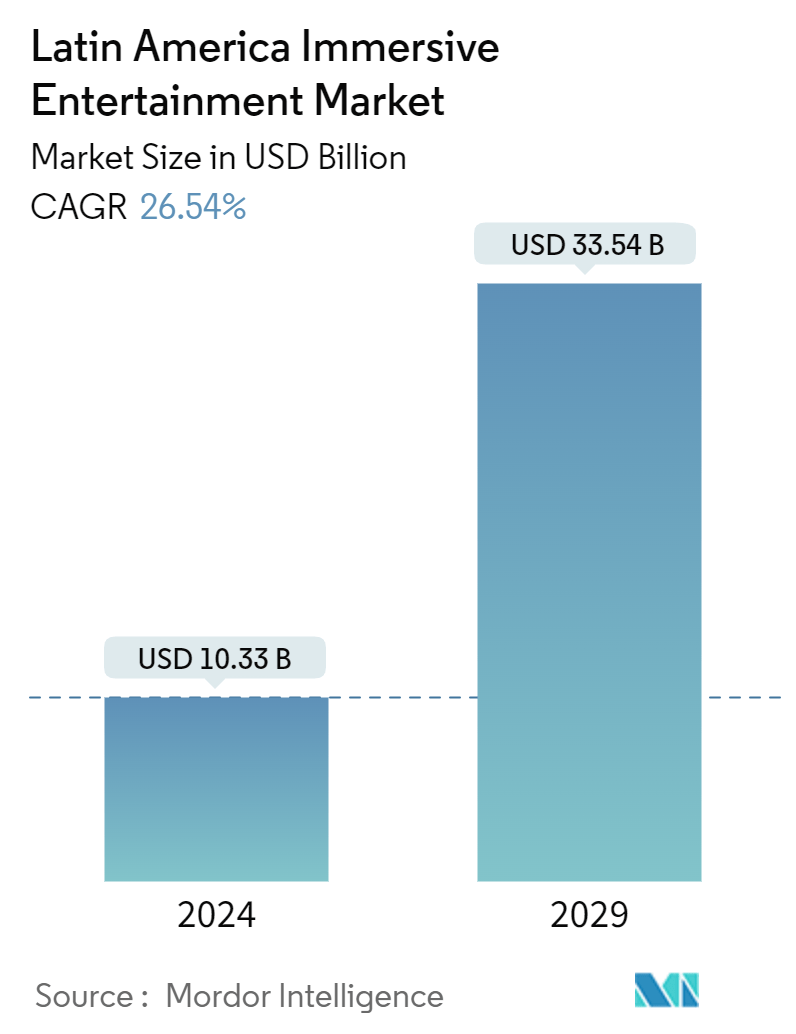Market Size of Latin America Immersive Entertainment Industry

| Study Period | 2019 - 2029 |
| Base Year For Estimation | 2023 |
| Market Size (2024) | USD 10.33 Billion |
| Market Size (2029) | USD 33.54 Billion |
| CAGR (2024 - 2029) | 26.54 % |
| Market Concentration | Medium |
Major Players
*Disclaimer: Major Players sorted in no particular order |
Latin America Immersive Entertainment Market Analysis
The Latin America Immersive Entertainment Market size is estimated at USD 10.33 billion in 2024, and is expected to reach USD 33.54 billion by 2029, growing at a CAGR of 26.54% during the forecast period (2024-2029).
- Immersive technologies are increasingly adopted in the entertainment industry, a trend poised to drive the market's growth in the coming years. Additionally, virtual tourism is gaining traction, allowing users to explore various destinations virtually. These evolving trends underscore the dynamic nature of immersive technologies in entertainment and highlight a shift in the market. The rise of virtual tourism signals an increasing demand for diverse and engaging immersive experiences, fundamentally changing audience interactions with entertainment.
- Further, the market is poised for growth, driven by the surge in location-based entertainment (LBE). LBE utilizes immersive technologies to create unique experiences in physical venues like theme parks and entertainment centers. By offering consumers innovative and interactive experiences that transcend traditional home entertainment, LBE significantly broadens the market. This trend is set to propel the growth of the immersive entertainment market during the forecast period. Additionally, the rise of virtual concerts and events allows consumers to enjoy live entertainment from the comfort of their homes, catering to evolving preferences for accessible experiences.
- For example, Sandbox VR is producing a full-body LBVR experience based on Netflix’s “Squid Game,” where contestants venture to iconic locations from the show to compete against one another. Motion Reality, Springboard VR, and Zero Latency all host similar free-roaming experiences for visitors equipped with tetherless VR and motion-capture gear to engage in highly immersive multiplayer battles set in massive virtual arenas. Family-friendly providers of standalone VR experiences include Dreamscape and DivrLabs, inviting guests to embark on virtual adventures set in fantasy realms, from prehistoric jungles to apocalyptic zombies.
- Further, VR arcades are innovating and offering more immersive experiences. VR arcades are expected to maintain healthy sales and a more significant market position in the immersive VR ecosystem. This is evident by the fact that among all the applications, VR arcades are expected to occupy the maximum share and have the fastest growth rate. In the next few years, high-end out-of-home immersive experiences, like Nomadic, Dreamscape, and The Void, are anticipated to develop and offer more affordable immersive experiences for the home. In the current market scenario, more content creators are building experiences specifically for VR Arcades. For instance, companies like Indie Studios realize they can generate positive profit margins by developing content specifically for the out-of-home VR space.
- Immersive technologies grapple with technical constraints tied to hardware, software, and content creation. For instance, VR headsets might offer a restricted field of view or resolution, diminishing the immersive experience. Similarly, AR applications can face challenges in accurately superimposing digital content onto the real world, influenced by environmental factors and the precision of device tracking. Furthermore, producing top-notch immersive content demands expertise in 3D modeling, animation, and interactive design, an intricate and time-intensive process.

